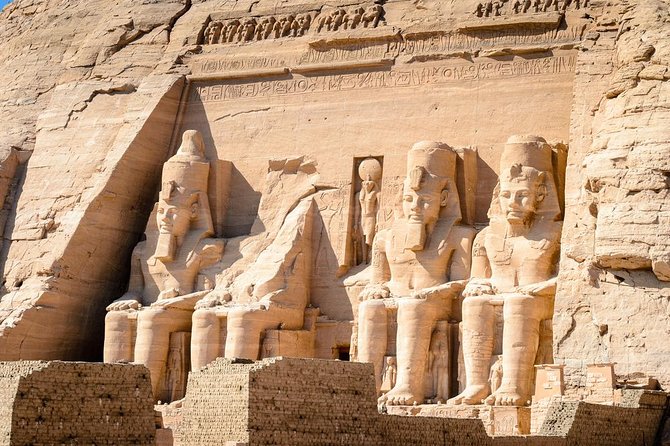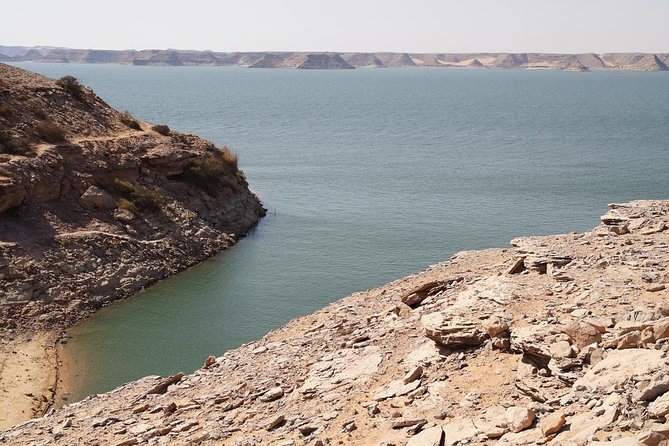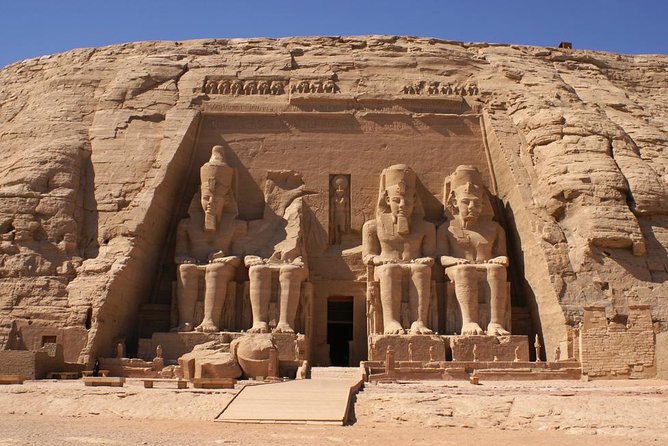Abu Simbel Temple, a remarkable creation from the reign of Pharaoh Ramses II, captivates visitors with its stunning architecture and historical significance. Carved directly into a mountainside, this ancient site features four massive statues of Ramses that evoke a sense of power and devotion. As one of Egypt’s UNESCO World Heritage sites, its intricate designs and precise astronomical alignments offer a glimpse into the advanced skills of ancient artisans. Yet, the story of Abu Simbel doesn’t end with its construction; it also involves a dramatic relocation process that speaks volumes about its importance. What led to this remarkable feat?
Good To Know

- Abu Simbel Temple, built during Pharaoh Ramses II’s reign, showcases ancient Egyptian artistry and serves as a political statement.
- The temple features four colossal statues of Ramses II, each approximately 20 meters high, carved into the mountainside.
- Notable for its intricate carvings and hieroglyphs, the site highlights Ramses’ victories and religious rituals.
- Early morning visits are recommended for fewer crowds and stunning sunrise views of the twin temples.
- Accessibility options, including wheelchair ramps and guided tours, ensure an enjoyable experience for all visitors.
Historical Significance

The Abu Simbel Temple, carved into the mountainside, stands as a monumental testament to ancient Egyptian artistry and engineering.
Built during the reign of Pharaoh Ramses II in the 13th century BCE, it served not only as a place of worship but also as a powerful political statement.
The temple complex, dedicated to Ramses himself and the deities Amun, Ra-Horakhty, and Ptah, symbolized Egypt’s strength and divine connection.
Its construction aimed to impress neighboring nations, showcasing Ramses’s authority and promoting the worship of the gods.
The site also played a critical role in the preservation of Egyptian history, with its relocation in the 1960s demonstrating international cooperation in safeguarding cultural heritage.
Today, it remains a symbol of ancient Egypt’s grandeur.
You can also read our reviews of more tours and experiences in Aswan.
Architectural Features

Carved into the solid rock of the mountainside, Abu Simbel Temple showcases the remarkable architectural prowess of ancient Egypt.
This grand structure features four colossal statues of Ramses II, each standing about 20 meters high, representing the pharaoh as both a god and a ruler. The temple’s entrance is flanked by two smaller statues of his queen, Nefertari, highlighting the importance of royal women in ancient society.
Inside, intricate carvings and hieroglyphs adorn the walls, depicting scenes of Ramses’ victories and religious rituals.
The temple’s alignment with the sun is particularly noteworthy; twice a year, sunlight illuminates the inner sanctum, a testament to the advanced understanding of astronomy possessed by the ancient Egyptians.
Visiting Abu Simbel
Visiting Abu Simbel offers travelers a unique glimpse into ancient Egyptian culture and architectural genius, all while surrounded by the stunning landscapes of Aswan. The journey begins early in the morning, ensuring visitors arrive before the heat of the day sets in.
Upon arrival, they’re greeted by the awe-inspiring twin temples carved into the mountainside, featuring colossal statues of Ramses II. Guided tours provide insight into the historical significance and intricate details of the temples, making the experience enriching.
Accessibility is prioritized, with facilities for all visitors. With its breathtaking scenery and profound history, Abu Simbel leaves a lasting impression, reminding everyone of Egypt’s remarkable past.
It’s a must-visit for anyone exploring this captivating region.
Tour Options and Pricing
Offering a range of options, the Abu Simbel Temple tour caters to various preferences and budgets. Starting at $95.00 per person, prices can vary based on group size.
Guests can expect private air-conditioned car transfers, a knowledgeable tour guide, and convenient hotel pick-up and drop-off in Aswan. The package also includes entrance fees, ensuring a hassle-free experience.
Tours kick off early at 04:00 am, and travelers receive confirmation at the time of booking. The cancellation policy is flexible, allowing for free cancellations up to 24 hours in advance.
With a stellar 4.5/5 rating, the tour promises an enriching experience without hidden costs, making it an attractive option for visitors eager to explore this historical site.
Accessibility Information

Abu Simbel Temple is designed to be accessible for a wide range of visitors, ensuring everyone can enjoy its magnificent beauty. The site offers facilities and services that cater to diverse needs, making it a welcoming destination.
| Feature | Availability | Notes |
|---|---|---|
| Wheelchair Access | Yes | Ramps available |
| Public Transport Nearby | Yes | Buses and taxis available |
| Guided Tours | Yes | Inclusive for all |
| Weather Considerations | All conditions | Dress appropriately |
Visitors can expect a well-organized experience, with options for assistance if needed. The temple’s commitment to accessibility ensures that everyone can appreciate its historical significance and stunning architecture.
Travel Tips
For a smooth and enjoyable experience at the Abu Simbel Temple, travelers should keep a few practical tips in mind.
First, they should arrive early to avoid crowds and capture the stunning sunrise views.
Second, wearing comfortable shoes is essential, as exploring the temple involves walking on uneven surfaces.
Third, travelers should carry water and snacks, as amenities are limited on-site.
Lastly, it’s wise to have a camera ready, as the intricate carvings and colossal statues provide countless photo opportunities.
Here’s a quick list:
- Arrive early for fewer crowds.
- Wear comfortable shoes for walking.
- Bring water and snacks.
- Don’t forget your camera for amazing photos.
Nearby Attractions
Visitors to the Abu Simbel Temple will find a wealth of nearby attractions that enhance their Egyptian adventure.
Just a short drive away, Lake Nasser offers breathtaking views and opportunities for boat trips. Travelers can explore the stunning landscapes while taking in the serene waters.
Plus, the Nubian Museum in Aswan showcases the rich history and culture of the Nubian people, with fascinating artifacts and exhibits.
For those interested in local markets, Aswan’s vibrant souks provide a perfect chance to experience traditional crafts, spices, and textiles.
Finally, the stunning Philae Temple, dedicated to the goddess Isis, is another must-visit site, accessible via a scenic boat ride.
These attractions ensure an unforgettable experience for every visitor.
Frequently Asked Questions
What Is the Best Time of Year to Visit Abu Simbel?
The best time to visit is between October and April. During these months, the weather’s milder, making outdoor explorations enjoyable. Travelers appreciate pleasant temperatures while soaking in the breathtaking views and rich history of the area.
Are There Dining Options Available Near the Temple?
Nearby dining options include local restaurants and cafes, offering traditional Egyptian cuisine. Visitors can enjoy authentic dishes after their tours, ensuring a complete cultural experience that complements the breathtaking sights they’ve just explored.
Can I Take Photographs Inside the Temple?
Visitors can’t take photographs inside the temple, as rules prohibit it to preserve the site. However, they can capture the stunning exterior and surrounding landscapes, ensuring memorable memories of their experience during the tour.
Is There a Dress Code for Visiting Abu Simbel?
Visitors should dress modestly when exploring cultural sites in Egypt. Light, breathable clothing covering shoulders and knees is recommended. It’s wise to check specific site requirements, as some places may have stricter guidelines.
How Long Should I Plan to Spend at the Temple?
Visitors should plan to spend about two to three hours exploring the temple. This timeframe allows for a thorough experience, including guided tours, photography opportunities, and appreciating the intricate architecture and historical significance of the site.
The Sum Up
Abu Simbel Temple is more than just an ancient structure; it embodies the grandeur of Egypt’s past and its cultural significance. Visitors can marvel at the impressive architectural features and intricate carvings while seeing the rich history of Ramses II. With accessible travel options and nearby attractions, a trip to this UNESCO World Heritage site promises an unforgettable experience. Exploring Abu Simbel connects travelers to the timeless legacy of one of history’s greatest civilizations.
More Tour Reviews in Aswan
Not for you? Here's more nearby things to do in Aswan we have reviewed
- Coptic Cairo Adventure: History, Culture, and Family Fun
- 8-Day Private Sightseeing Excursion With Nile Cruise From Cairo Airport.Hot Deal
- Private Abusimbel Day Tour With Lunch
- Private Tour to Abu Simbel From Aswan
- Edfu & Kom Ombo – Stop at Aswan
- Kalabsha Temple and Nubian Museum Day Tour From Aswan
- 3 Days Private Tour to Abu Simble, Balloon Ride, Aswan and Luxor
- 04 Days – 03 Nights Nile Cruise From Aswan to Luxor With Tours and Guide
- 2 Hours Sandboarding in the Desert of Aswan
- Aswan PRIVATE Tour, Philae Temple, High Dam and Unfinished Obelisk
- Aswan Airport: Private Transfer To/From Abu Simbel’S Hotels
- Sound And Light Show At Philae Temple In Aswan
